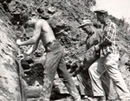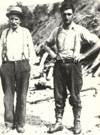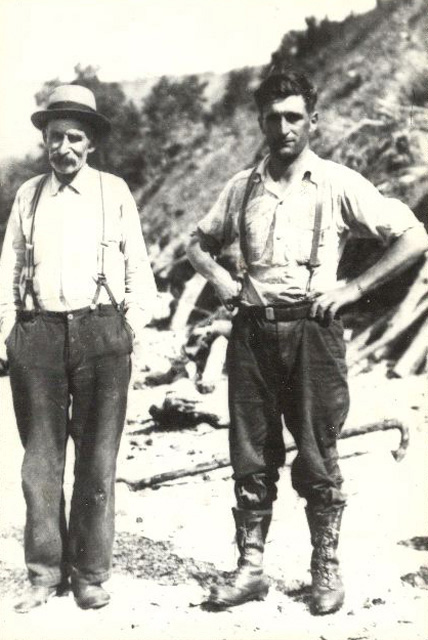Of cliffs and men

 (96 kb) This history officially began in 1842 when a geologist exploring for coal discovered the Miguasha site. No existing documents mention it prior to this date, although there is every reason to believe that local people were aware of the site.
(96 kb) This history officially began in 1842 when a geologist exploring for coal discovered the Miguasha site. No existing documents mention it prior to this date, although there is every reason to believe that local people were aware of the site.In the grander scheme of things, Miguasha’s discovery was one in a series of historic scientific events that would profoundly influence each other. To begin with, the Industrial Revolution was in full swing, and coal was highly prized by developing societies with their ever-increasing demand for energy. It is only fitting, then, that Miguasha’s discoverer was exploring for coal!

 (52 kb)During this era of rapid change, the field of biology experienced a flurry of excitement as naturalists worked diligently to classify the scores of living species they were collecting from far and wide. Not to mention that the concept of the evolution of species, a subversive idea at that time, was beginning to break through the resistance and even became accepted in some circles. Geology was also flourishing, and nations created geological commissions with a mandate to map the Earth’s surface and subsurface. It was in this spirit that the Geological Survey of Canada was created in 1843.
(52 kb)During this era of rapid change, the field of biology experienced a flurry of excitement as naturalists worked diligently to classify the scores of living species they were collecting from far and wide. Not to mention that the concept of the evolution of species, a subversive idea at that time, was beginning to break through the resistance and even became accepted in some circles. Geology was also flourishing, and nations created geological commissions with a mandate to map the Earth’s surface and subsurface. It was in this spirit that the Geological Survey of Canada was created in 1843.In Europe, scholars had just discovered the Old Red Sandstone in Scotland and northern England, and the definition of the Devonian System was still in its infancy. Paleontology was still a young discipline, but it was a time of rapid discovery, with new finds announced one after another at an astonishing pace. And leaving his indelible mark on this moment in history, British paleontologist Richard Owen coined the term “dinosaur”.

 (80 kb)Amidst this feverish scientific activity, Dr. Abraham Gesner discovered the fossil-rich site at Miguasha in 1842. Unfortunately, it barely made a ripple in the scientific community at the time, and the human history of the cliffs would not begin in earnest until 37 years later.
(80 kb)Amidst this feverish scientific activity, Dr. Abraham Gesner discovered the fossil-rich site at Miguasha in 1842. Unfortunately, it barely made a ripple in the scientific community at the time, and the human history of the cliffs would not begin in earnest until 37 years later.
Title: Fossil digging in 1964
Author: Claude Bureau
Sources: Parc national de Miguasha
Year: 1964
Description:
Fossil digging at the Miguasha cliff in 1964. René Bureau is holding the jack hammer; Euclide Plourde is behind him, and Euclide’s son Ralph is digging on the left.

Title: Antoine and Euclide Plourde
Author: René Bureau
Sources: Parc national de Miguasha
Year: 1937
Description:
Antoine Plourde, left, with his son Euclide on the beach at Miguasha in 1937. Photographed by René Bureau during his first trip to Miguasha.

Title: Marius Arsenault and Hans-Peter Schultze
Author: Parc national de Miguasha
Sources: Parc national de Miguasha
Year: 1984
Description:
Taken in 1984, this photo shows Marius Arsenault and Hans-Peter Schultze while they were studying the skull of an Elpistostege discovered by Allen Parent. Marius Arsenault was actively involved in developing the fossiliferous site at Miguasha. He arrived in 1977 with the first teams from the Université du Québec à Rimouski, and opened the first interpretation centre in 1978. He was the first park director when the Parc national de Miguasha was created in 1985, a post he held until 2003.


